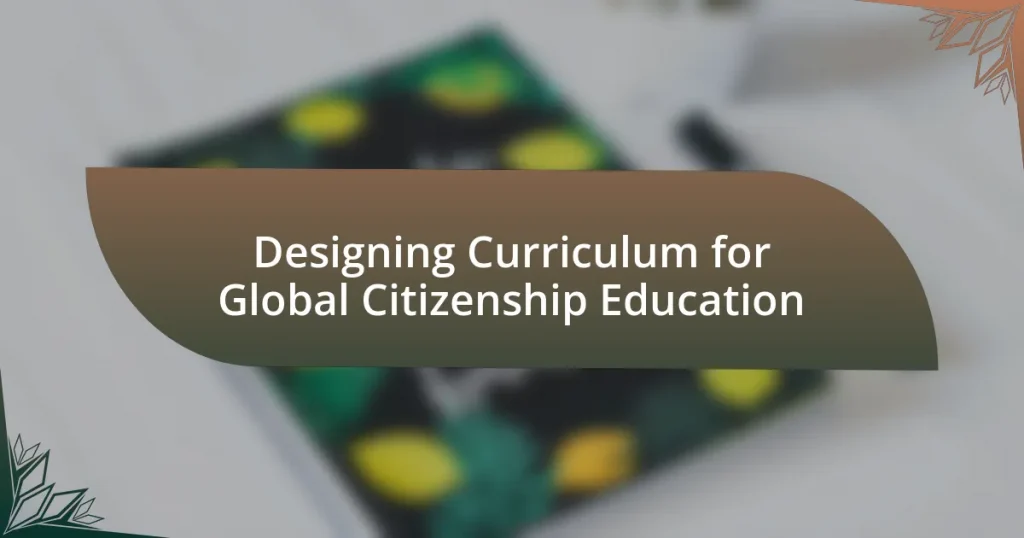Designing Curriculum for Global Citizenship Education focuses on creating educational frameworks that equip learners with essential knowledge, skills, and values for effective engagement in a globalized world. The curriculum emphasizes critical thinking, cultural awareness, and social responsibility, aiming to enhance students’ understanding of global issues and promote active participation in local and global communities. Key principles include inclusivity, critical thinking, and social responsibility, while the curriculum addresses challenges such as climate change and social inequality. Effective implementation requires interdisciplinary approaches, resources, and strategies for assessment, ensuring that students develop critical thinking, empathy, and civic engagement skills necessary for navigating an interconnected world.

What is Designing Curriculum for Global Citizenship Education?
Designing Curriculum for Global Citizenship Education involves creating educational frameworks that equip learners with the knowledge, skills, and values necessary to engage effectively in a globalized world. This curriculum emphasizes critical thinking, cultural awareness, and social responsibility, aiming to foster active participation in local and global communities. Research indicates that such curricula can enhance students’ understanding of global issues, promote empathy, and encourage collaborative problem-solving, which are essential for addressing challenges like climate change and social inequality.
Why is Global Citizenship Education important in today’s world?
Global Citizenship Education is important in today’s world because it fosters awareness and understanding of global issues, promoting empathy and responsibility among individuals. This education equips learners with the skills to engage in a diverse and interconnected world, addressing challenges such as climate change, inequality, and conflict. According to UNESCO, Global Citizenship Education enhances critical thinking and encourages active participation in society, which is essential for building peaceful and sustainable communities.
What are the key principles of Global Citizenship Education?
The key principles of Global Citizenship Education (GCE) include inclusivity, critical thinking, and social responsibility. Inclusivity ensures that all learners, regardless of background, have access to education that promotes understanding of global issues. Critical thinking encourages students to analyze and question information, fostering informed decision-making. Social responsibility emphasizes the importance of active participation in local and global communities, promoting actions that contribute to a more just and sustainable world. These principles are supported by UNESCO’s framework for GCE, which highlights the need for education to empower individuals to engage with global challenges effectively.
How does Global Citizenship Education contribute to social cohesion?
Global Citizenship Education (GCE) contributes to social cohesion by fostering mutual respect, understanding, and collaboration among diverse groups. GCE promotes awareness of global issues and encourages learners to engage with different cultures, which helps to break down stereotypes and prejudices. Research indicates that educational programs emphasizing global citizenship lead to increased empathy and social responsibility, as evidenced by a study conducted by the Global Education Monitoring Report, which found that students exposed to GCE are more likely to participate in community service and civic activities. This active engagement in social issues strengthens community ties and enhances social cohesion.
What are the main goals of a curriculum designed for Global Citizenship Education?
The main goals of a curriculum designed for Global Citizenship Education are to foster critical thinking, promote social responsibility, and encourage active participation in local and global communities. This curriculum aims to equip learners with the knowledge, skills, and values necessary to understand and address global challenges, such as inequality, climate change, and human rights. By integrating diverse perspectives and promoting intercultural understanding, the curriculum prepares students to engage effectively in a interconnected world. Research indicates that such educational frameworks enhance students’ awareness of global issues and empower them to take informed actions, thereby contributing to a more just and sustainable society.
How can a curriculum foster critical thinking and empathy?
A curriculum can foster critical thinking and empathy by integrating problem-based learning and diverse perspectives into its framework. Problem-based learning encourages students to analyze real-world issues, promoting critical thinking as they evaluate solutions and consequences. Incorporating diverse perspectives, such as through literature from various cultures or discussions on social justice, helps students understand different viewpoints, thereby enhancing empathy. Research indicates that curricula emphasizing these elements lead to improved cognitive skills and emotional intelligence, as evidenced by studies showing that students exposed to diverse narratives demonstrate greater empathy and critical analysis abilities.
What skills should students develop through Global Citizenship Education?
Students should develop critical thinking, empathy, intercultural communication, and civic engagement skills through Global Citizenship Education. Critical thinking enables students to analyze global issues and make informed decisions. Empathy fosters understanding and respect for diverse cultures and perspectives, which is essential in a globalized world. Intercultural communication skills allow students to effectively interact with individuals from different backgrounds, enhancing collaboration and conflict resolution. Civic engagement encourages active participation in local and global communities, promoting social responsibility and awareness of global challenges. These skills are vital for preparing students to navigate and contribute positively to an interconnected world.
What challenges exist in designing a curriculum for Global Citizenship Education?
Designing a curriculum for Global Citizenship Education faces several challenges, including cultural diversity, varying educational standards, and the need for interdisciplinary approaches. Cultural diversity complicates curriculum design as it requires sensitivity to different values, beliefs, and practices, which can lead to conflicts or misunderstandings among students. Additionally, varying educational standards across regions can hinder the implementation of a cohesive curriculum, making it difficult to ensure that all students receive a consistent and comprehensive education in global citizenship. Furthermore, the need for interdisciplinary approaches poses a challenge, as effective global citizenship education often requires integrating knowledge from multiple subjects, which can be difficult to coordinate within traditional educational frameworks.
How can educators address cultural differences in curriculum design?
Educators can address cultural differences in curriculum design by incorporating diverse perspectives and culturally relevant materials into the curriculum. This approach ensures that the educational content reflects the backgrounds and experiences of all students, fostering inclusivity and engagement. Research indicates that culturally responsive teaching improves student achievement and motivation, as evidenced by a study published in the “Journal of Educational Psychology,” which found that students from diverse backgrounds performed better when their cultural contexts were integrated into the learning process. By actively seeking input from various cultural communities and adapting teaching methods to accommodate different learning styles, educators can create a more equitable and effective curriculum.
What resources are necessary for effective curriculum implementation?
Effective curriculum implementation requires a combination of human, material, and financial resources. Human resources include trained educators who possess the necessary skills and knowledge to deliver the curriculum effectively. Material resources encompass textbooks, digital tools, and other instructional materials that support the learning process. Financial resources are essential for acquiring these materials and providing professional development opportunities for educators. Research indicates that schools with adequate resources see improved student outcomes, as highlighted in the study “The Impact of Resources on Student Achievement” by the National Center for Education Statistics, which shows a direct correlation between resource availability and academic performance.
How can educators effectively implement Global Citizenship Education in their classrooms?
Educators can effectively implement Global Citizenship Education (GCE) in their classrooms by integrating interdisciplinary approaches that promote critical thinking, empathy, and awareness of global issues. This can be achieved through project-based learning, where students engage in real-world problems, fostering collaboration and communication skills essential for global citizenship. Research indicates that programs incorporating GCE principles lead to increased student engagement and a deeper understanding of cultural diversity, as evidenced by the findings of the “Global Citizenship Education: Preparing Learners for the Challenges of the 21st Century” report by UNESCO, which highlights the importance of active participation in fostering global awareness.
What strategies can be used to assess student learning in Global Citizenship Education?
Strategies to assess student learning in Global Citizenship Education include formative assessments, project-based learning, and reflective journals. Formative assessments, such as quizzes and class discussions, provide ongoing feedback on student understanding of global issues. Project-based learning allows students to engage in real-world problems, demonstrating their ability to apply knowledge in practical contexts. Reflective journals encourage students to articulate their thoughts and experiences related to global citizenship, fostering critical thinking and self-assessment. These strategies collectively enhance the evaluation of student learning by aligning assessment methods with the objectives of Global Citizenship Education.

What are the key components of a successful Global Citizenship Education curriculum?
A successful Global Citizenship Education curriculum includes critical thinking, intercultural understanding, and active participation. Critical thinking enables students to analyze global issues and understand diverse perspectives, fostering informed decision-making. Intercultural understanding promotes respect for different cultures and encourages empathy, which is essential in a globalized world. Active participation empowers students to engage in community service and advocacy, reinforcing their role as responsible global citizens. Research by the Global Education Monitoring Report (2016) highlights that these components are vital for developing competencies necessary for addressing global challenges.
What topics should be included in the curriculum?
The curriculum for Global Citizenship Education should include topics such as human rights, environmental sustainability, cultural diversity, social justice, and global interdependence. These topics are essential as they equip learners with the knowledge and skills necessary to engage with global issues critically and empathetically. For instance, understanding human rights fosters respect for individual dignity, while environmental sustainability emphasizes the importance of protecting the planet for future generations. Research by UNESCO highlights that integrating these topics into education promotes active citizenship and prepares students to contribute positively to society.
How can current global issues be integrated into the curriculum?
Current global issues can be integrated into the curriculum by incorporating interdisciplinary approaches that connect subjects like social studies, science, and language arts to real-world challenges. For instance, educators can design projects that address climate change, poverty, or human rights, allowing students to engage with these topics through research, discussions, and community involvement. This method not only enhances critical thinking but also fosters a sense of global responsibility among students. Research from the Global Education Monitoring Report indicates that curricula that include global issues lead to improved student engagement and awareness of international perspectives, thereby validating the effectiveness of this integration.
What role do local contexts play in curriculum development?
Local contexts play a crucial role in curriculum development by ensuring that educational content is relevant and responsive to the specific cultural, social, and economic needs of a community. This relevance enhances student engagement and learning outcomes, as curricula that reflect local realities are more likely to resonate with learners. For instance, research by the Organisation for Economic Co-operation and Development (OECD) highlights that curricula tailored to local contexts can improve educational equity and effectiveness, as they address the unique challenges and opportunities present in different regions. By integrating local knowledge, values, and practices, curriculum developers can create educational experiences that foster global citizenship while remaining grounded in the local environment.
How can interdisciplinary approaches enhance Global Citizenship Education?
Interdisciplinary approaches enhance Global Citizenship Education by integrating diverse perspectives and knowledge areas, fostering critical thinking and problem-solving skills essential for addressing global challenges. For instance, combining insights from social sciences, environmental studies, and ethics allows students to understand complex issues like climate change and social justice from multiple angles. Research by the Global Education Monitoring Report (2019) highlights that interdisciplinary curricula promote deeper engagement and understanding, as students learn to connect concepts across disciplines, leading to more informed and active global citizens.
What subjects can be combined to create a holistic curriculum?
A holistic curriculum can be created by combining subjects such as social studies, environmental science, ethics, and the arts. Social studies provide context for understanding global citizenship, while environmental science fosters awareness of ecological issues. Ethics encourages critical thinking about moral responsibilities, and the arts promote creativity and cultural appreciation. Research indicates that interdisciplinary approaches enhance student engagement and understanding, as shown in studies like “Interdisciplinary Learning: A Review of the Literature” by Beers and Ritchie, which highlights the effectiveness of integrating diverse subjects for comprehensive education.
How does collaboration among educators improve curriculum effectiveness?
Collaboration among educators improves curriculum effectiveness by fostering diverse perspectives and shared expertise, which enhances the quality and relevance of educational content. When educators work together, they can integrate various teaching methods and resources, leading to a more comprehensive curriculum that addresses the needs of all students. Research indicates that collaborative practices among teachers can lead to improved student outcomes, as evidenced by a study published in the “Journal of Educational Psychology,” which found that schools with collaborative teaching environments saw a 20% increase in student engagement and achievement. This collaborative approach not only enriches the curriculum but also promotes a culture of continuous improvement and innovation in teaching practices.

What best practices should be followed in designing a curriculum for Global Citizenship Education?
Best practices in designing a curriculum for Global Citizenship Education include integrating interdisciplinary approaches, promoting critical thinking, and fostering active participation. Interdisciplinary approaches allow students to connect global issues with various subjects, enhancing their understanding of complex interdependencies. Promoting critical thinking equips learners to analyze and evaluate information, fostering informed decision-making. Active participation encourages students to engage in community service and global initiatives, reinforcing their role as responsible global citizens. Research by the Global Education Monitoring Report (2019) emphasizes that curricula incorporating these elements lead to improved student engagement and a deeper understanding of global citizenship concepts.
How can educators ensure inclusivity in their curriculum design?
Educators can ensure inclusivity in their curriculum design by integrating diverse perspectives and materials that reflect the backgrounds and experiences of all students. This approach involves incorporating multicultural content, using varied teaching methods to accommodate different learning styles, and actively seeking input from students and communities to inform curriculum choices. Research indicates that inclusive curricula enhance student engagement and achievement, as evidenced by a study published in the “Journal of Educational Psychology,” which found that students exposed to diverse perspectives showed improved critical thinking skills and greater empathy.
What methods can be used to gather feedback from students and communities?
Surveys and questionnaires are effective methods to gather feedback from students and communities. These tools allow for the collection of quantitative and qualitative data, enabling educators to assess opinions, experiences, and suggestions regarding the curriculum. Research indicates that structured surveys can yield high response rates, particularly when distributed electronically, as seen in studies conducted by the National Center for Education Statistics, which reported that online surveys can increase participation by up to 30%. Additionally, focus groups provide a platform for in-depth discussions, allowing participants to express their views in a collaborative environment. This method has been shown to uncover insights that may not emerge from surveys alone, as highlighted in the work of Krueger and Casey on focus group methodology. Furthermore, community forums and town hall meetings facilitate direct engagement, fostering a sense of ownership and involvement among stakeholders. These methods collectively enhance the feedback process, ensuring that diverse perspectives are considered in curriculum design for global citizenship education.
How can continuous improvement be integrated into curriculum development?
Continuous improvement can be integrated into curriculum development by implementing a systematic feedback loop that involves regular assessment and revision of educational content. This approach ensures that the curriculum remains relevant and effective in meeting the needs of students and the demands of a globalized society. For instance, educational institutions can utilize data from student performance metrics, stakeholder surveys, and emerging global issues to inform curriculum updates. Research by the National Education Association highlights that iterative feedback mechanisms lead to enhanced learning outcomes, demonstrating the effectiveness of continuous improvement in educational settings.
What practical tips can educators use to enhance Global Citizenship Education in their teaching?
Educators can enhance Global Citizenship Education by integrating real-world issues into their curriculum. This approach allows students to engage with topics such as climate change, social justice, and human rights, fostering critical thinking and empathy. For instance, incorporating project-based learning that addresses local and global challenges encourages students to collaborate and develop solutions, which aligns with the principles of global citizenship. Research shows that experiential learning, such as community service projects, significantly increases students’ awareness and commitment to global issues, as evidenced by a study published in the Journal of Global Citizenship & Equity Education, which found that students involved in service-learning reported higher levels of civic engagement and social responsibility.
